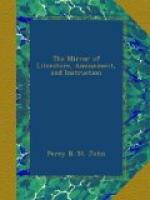LIBRARY OF ENTERTAINING KNOWLEDGE.
FRUITS.
This Part (5) completes the volume of “Vegetable Substances used in the Arts and in Domestic Economy.” The first portion—Timber Trees was noticed at some length in our last volume (page 309,) and received our almost unqualified commendation, which we are induced to extend to the Part now before us. Still, we do not recollect to have pointed out to our readers that which appears to us the great recommendatory feature of this series of works—we mean the arrangement of the volumes—their subdivisions and exemplifications—and these evince a master-hand in compilation.
Every general reader must be aware that little novelty could be expected in a brief History and Description of Timber Trees and Fruits, and that the object of the Useful Knowledge Society was not merely to furnish the public with new views, but to present in the most attractive form the most entertaining facts of established writers, and illustrate their views with the observations of contemporary authors as well as their own personal acquaintance with the subjects. In this manner, the Editor has taken “a general and rapid view of fruits,” and, considering the great hold their description possesses on all readers, we are disposed to think almost too rapid. We should have enjoyed a volume or two more than half a volume of such reading as the present; but as we are not purchasers, and are unacquainted with the number to which the Society propose to extend their works, we ought not perhaps to raise this objection, which, to say the truth, is a sort of negative commendation. Hitherto, we have been accustomed to see compilations of pretensions similar to the present, executed with little regard to neatness or unity, or weight or consideration. Whole pages and long extracts have been stripped and sliced off books, with little rule or arrangement, and what is still worse, without any acknowledgment of the sources. The last defect is certainly the greatest, since, in spite of ill-arrangement, an intelligent inquirer may with much trouble, avail himself of further reference to the authors quoted, and thus complete in his own mind what the compiler had so indifferently begun. The work before us is, however, altogether of a much higher order than general compilations. The introductions and inferences are pointed and judicious, and the facts themselves of the most interesting character, are narrated in a condensed but perspicuous style; while the slightest reference will prove that the best and latest authorities have been appreciated. Thus, in the History and Description of Fruits, the Transactions of the Horticultural Society are frequently and pertinently quoted to establish disputed points, as well as the journals of intelligent travellers and naturalists; with occasional poetical embellishments, which lend a charm even to this attractive species of reading.
To quote the history of either Fruit entire, would not so well denote the character of the work as would a few of the most striking passages in the descriptions. In the introductory chapter we are pleased with the following passage on Monastic Gardens.




